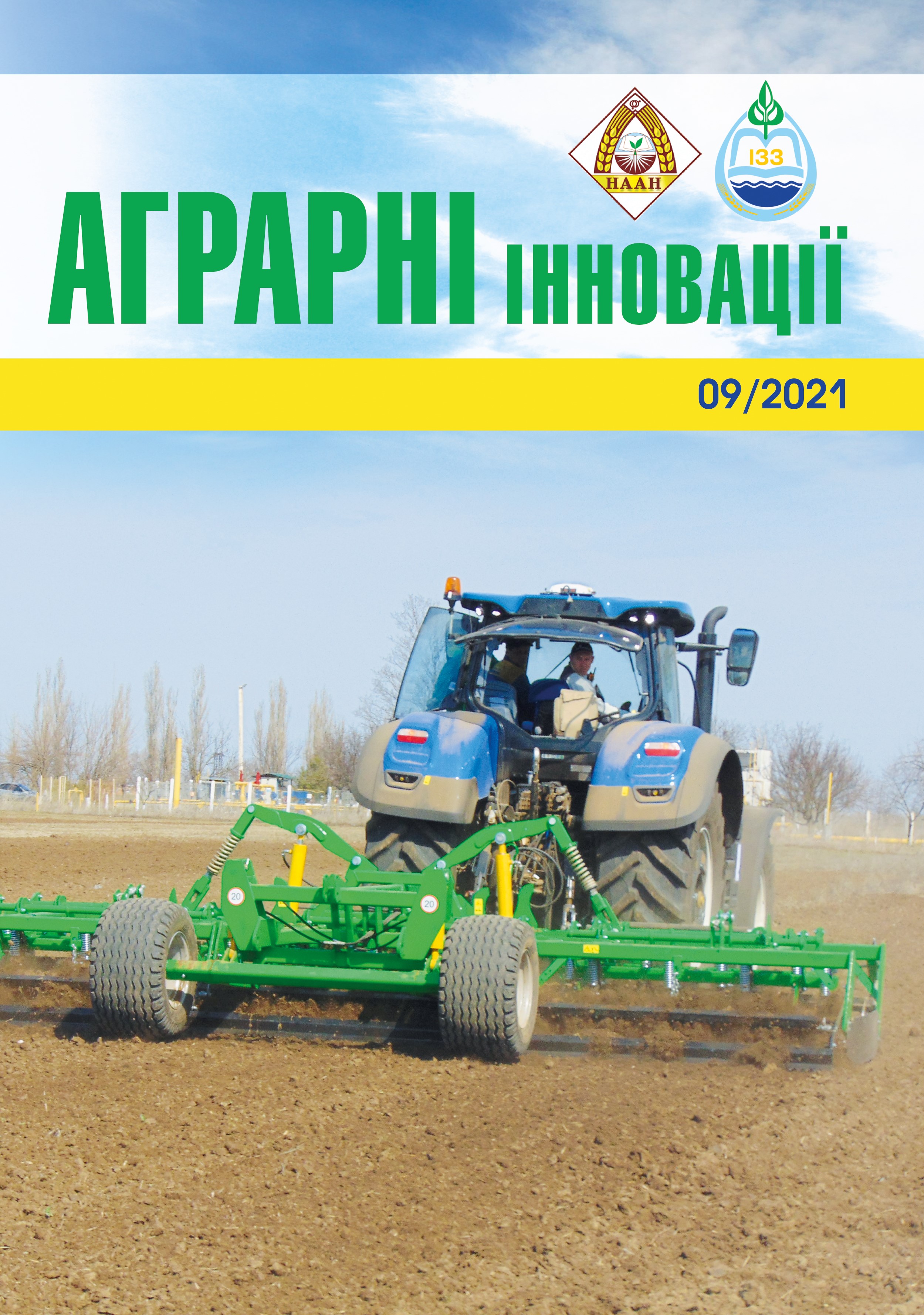Productivity of winter wheat on chernozem typical soil Right Bank Forest Steppe of Ukraine
Abstract
The purpose of the research was to determine the influence of preceding crops and the method and depth of the main tillage on the formation of winter wheat productivity. Methods. Experimental studies were carried out on chernozem typical in a stationary field experiment of the Educational, Scientific and Innovative Center of Agricultural Technologies LLC «Agrofirma Kolos», Pustovarovka village, Kiev region. In the course of the study the following scientific methods were used: analysis, synthesis, field and statistical methods. The influence of the method of basic tillage – plowing to a depth of 20–22 cm was studied; chisel-cultivating to a depth of 20–22 cm; disking to a depth of 12-14 cm; disking to a depth of 6–8 cm. And preceding crops – peas; winter rape; soybean; sunflower; corn for silage on the formation of productivity of winter wheat. Results. It was found that on average for 2019–2021. The highest yield of winter wheat of 6,39 and 5,73 t/ha was ensured when it was placement after peas and soybeans with shelf tillage by 12–14 cm (disc harrow). The use of winter rapeseed and sunflower as a preceding crops, the highest yield of winter wheat – 6,10 and 5,94 t/ha, respectively, made it possible to carry out shelf main tillage at 20–22 cm (chisel cultivator) the lowest yield of agricultural crops was obtained, which, depending on the tillage, ranged from 5,01 to 5,28 t/ha. Conclusion. The highest quality indicators of winter wheat grain – protein content of 13,1 and 13.3% and gluten content of 25,2 and 25,5 % were obtained when it was placed after legumes (peas and soybeans). Winter rape, like its preceding crops, gave quality indicators of grain at the level of 13,0 % protein and 24,5 % gluten. When applied to silage after sunflower and corn, the protein content in the winter wheat grain was 12,6 and 12,8 %, respectively, and the gluten content was 24,0 and 24,1 %.
References
2. Demidov O., Pravdziva I., Gudzenko V., Rysin A., Vologina G., Siroshtan A., Yurchenko T., Zaima O., Misyura I. Formation of flour quality indicators in different winter wheat (Triticum aestivum L.) genotypes depending on abiotic and anthropogenic factors. Ukrainian Ecological Journal. 2021. Issue. 11 (8). R. 111–118.
3. Marenych M.M., Kaminsky V.F., Bulygin C.Y., Hanhur V.V., Korotkova I.V., Yurchenko S.O., Bahan A.V., Taranenko S.V., & Liashenko V.V. Optimization of factors of managing productive processes of winter wheat in the Forest-steppe. Agricultural Science and Practice. 2020. Vol. 7(2). Р. 44–54. https://doi.org/10.15407/agrisp7.02.044.
4. Petrychenko V.F., Lykhochvor V.V., Korniichuk O.V., Olifir Y.M. The yield of winter wheat depending on sowing terms. Ukrainian Journal of Ecology. 2021. № 11(3), Р. 161–166. doi: 10.15421/2021_158
5. Rae ZH. A. Comparative Evaluation of the Effects of Soil and Fertilizer Treatment on Winter Wheat Cultivation. Glob J Oto. 2018 № 12 (4): 555846. DOI: 10.19080/GJO.2018.12.555846
6. Siroshtan Andrii, Kavunets Valerii, Derhachov Oleksandr, Pykalo Serhii, Ilchenk Liudmyla. Yield and Sowing Qualities of Winter Bread Wheat Seeds Depending on the Preceding Crops and Sowing Dates in the Forest–Steppe of Ukraine. American Journal of Agriculture and Forestry. 2021. Vol. 9. No. 2. pp. 76–82. doi: 10.11648/j.ajaf.20210902.15
7. Tsvey Yaroslav, Ivanina Roman, Ivanina Vadym, Senchuk Svitlana. Yield and quality of winter wheat (Triticum aestivum L.) grain in relation to nitrogen fertilization. Rev. Fac. Nac. Agron. Medellín [online]. 2021. Vol.74, n.1 [cited 2021–11–21], pp. 9413–9422. Available from:
8. Yalcin H., Cakir E., Aykas E. Tillage parameters and economic analysis of direct seeding, minimum and conventional tillage in wheat. Journal of Agronomy. 2005. № 4. Р. 329–332.
9. Горобець А.Х., Цилюрик А.І., Горбатенко А.І., Судак В.М. Вологозабезпеченість і продуктивність польових культур за різних систем обробітку ґрунту в сівозміні. Вісник Інституту землеробства степової зони НААН України. 2011. №1. С. 20–25.
10. Інформаційно-аналітичне агентство AПК–Інформ. Посівні дані під урожай 2020 року. URL: https://www.apk–inform.com/uk/news/1507018.
11. Кернесюк Ю.В. Глобальний ринок пшениці: кон’юнктура і тренди Агробізнес сьогодні. URL: http://agro-business.com.ua/agro/ekonomichnyi-hektar/item/19645-hlobalnyi-rynok-pshenytsi-koniunktura-itrendy.html. (дата звернення: 26 листопада 2020 р.).
12. Кривенко А.І. Оптимізація норм і термінів підживлення пшениці озимої азотними добривами у Південному Степу України. Вісник аграрної науки Причорномор’я. 2018. № 4 (100). С. 55–61.
13. Панфілова А.В., Гамаюнова В.В., Дробітько А.В. Урожайність пшениці озимої залежно від попередника та біодеструктора стерні. Вісник Полтавської державної аграрної академії. 2019. № 3. С 18–25. https://doi.org/10.31210/visnyk2019.03.02
14. Петриченко В.Ф., Корнійчук О.В. Фактори стабілізації виробництва зерна пшениці озимої в Лісостепу правобережному. Вісник аграрної науки. 2018. № 2. С. 17–23.
15. Рыков В.Б., Камбулов С.И., Камбулов И.А., Колесник В.В., Дёмина Е.Б., Ридный С.Д., Янковский Н.Г. Продуктивность озимой пшеницы и технологии обработки почвы. Зерновое хозяйство России. 2015. № 5. С. 63–65.






